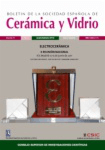
BOLETIN DE LA SOCIEDAD ESPANOLA DE CERAMICA Y VIDRIO
Scope & Guideline
Empowering Research in the Evolving World of Materials Science
Introduction
Aims and Scopes
- Ceramic Materials Science:
Research exploring the synthesis, characterization, and application of various ceramic materials, including bioceramics, piezoelectric ceramics, and structural ceramics. - Glass Science and Technology:
Studies focusing on the properties, processing, and applications of glass, including bioactive glasses, glass-ceramics, and specialty glasses. - Sustainable Materials and Processes:
Investigation into sustainable practices in ceramics and glass production, including the use of recycled materials, waste management, and environmentally friendly processing techniques. - Advanced Characterization Techniques:
Utilization of advanced analytical methods for the characterization of ceramic and glass materials, including structural, thermal, and mechanical properties. - Innovative Applications:
Research on novel applications of ceramic and glass materials in various fields, such as construction, biomedical engineering, and electronics.
Trending and Emerging
- Functional Nanostructured Materials:
There is an increasing focus on the development and application of nanostructured materials, including nanoparticles and nanocomposites, for enhanced performance in various applications. - Bioceramics and Biomedical Applications:
Research on bioceramics, particularly for applications in tissue engineering and regenerative medicine, is gaining prominence, reflecting the growing intersection of materials science and healthcare. - Eco-Friendly and Sustainable Practices:
The journal is increasingly publishing studies on eco-friendly materials and processes, emphasizing the importance of sustainability in the ceramics and glass industries. - Advanced Characterization and Modeling Techniques:
There is a trend towards employing sophisticated characterization techniques and computational modeling to better understand material properties and behaviors. - Smart and Functional Ceramics:
Research into smart ceramics, which respond to environmental stimuli, and their applications in sensors and actuators is emerging as a significant area of interest.
Declining or Waning
- Traditional Ceramic Techniques:
Research focused on conventional methods of ceramic production and processing has seen a decline, possibly due to the rise of advanced manufacturing techniques such as 3D printing and additive manufacturing. - Historical Ceramics and Archaeometry:
While still relevant, the frequency of studies on historical ceramics and archaeological materials has decreased, as the journal shifts towards contemporary applications and innovations in the field. - Simple Glass Formulations:
Investigations into basic glass compositions and formulations are becoming less frequent, as the focus has expanded towards more complex and functional glass systems.
Similar Journals

JOURNAL OF CERAMIC PROCESSING RESEARCH
Advancing the Frontiers of Ceramic InnovationJOURNAL OF CERAMIC PROCESSING RESEARCH, published by the Korean Association for Crystal Growth, Inc., serves as a vital source of scholarly communication in the field of ceramics and composites. With an ISSN of 1229-9162, this well-regarded journal aims to advance knowledge through rigorous research and publication of innovative studies that push the boundaries of ceramic processing technologies. Indexed in Scopus and boasting a 2023 Q3 ranking in the ceramics category, it provides a platform for researchers to disseminate their findings and engage with emerging trends in material science. The journal reflects a commitment to contributing to the scientific community, emphasizing the importance of interdisciplinary collaboration and advancements in fabrication techniques. Although it operates under a traditional access model, the journal is a beacon for researchers, professionals, and students, inviting them to explore breakthroughs from the years 2000 through 2024 and beyond.

Journal of the Korean Ceramic Society
Leading the way in ceramic materials research and discovery.The Journal of the Korean Ceramic Society is a premier academic journal dedicated to advancing the field of ceramics and composites, serving as a vital platform for researchers, professionals, and students alike. Published by SPRINGER HEIDELBERG, this journal boasts an impressive scopus rank of #49 out of 127 in the Materials Science category, with a commendable 61st percentile ranking, highlighting its impact and relevance in contemporary research. Since its inception, the journal has been converging significant research contributions from 2007 to 2024, consistently fostering innovation in ceramic materials and their diverse applications. Although it operates under a traditional access model, the journal remains committed to disseminating high-quality research in ceramics and composites, currently positioned in the Q2 category for 2023. With a strategic focus on the latest developments, methodologies, and interdisciplinary approaches, the Journal of the Korean Ceramic Society is essential reading for anyone engaged in materials science and engineering, aiming to navigate the complexities of this dynamic field.
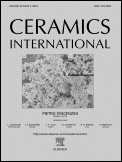
Ceramics International
Elevating the standards of ceramics research worldwide.Ceramics International is a premier journal published by ELSEVIER SCI LTD, focusing on advancing the field of materials science with a specific emphasis on ceramics and composites. With an impressive impact factor and a top-tier standing in several critical categories, including Q1 rankings in Ceramics and Composites, Electronic, Optical and Magnetic Materials, and Materials Chemistry, this journal serves as a crucial resource for researchers and professionals alike. Established in 1981, it has consistently showcased cutting-edge research in various domains, including surfaces, coatings, and process chemistry technologies, making it invaluable for those advancing theoretical and practical knowledge in these areas. While access is through subscription, the journal’s rich content, profound insights, and rigorous peer-review process ensure high-quality articles that contribute meaningfully to the scientific community. By fostering innovation and collaboration through rigorous research, Ceramics International stands out as an authoritative source for those dedicated to the evolution of materials science.
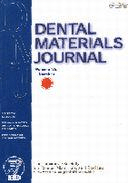
DENTAL MATERIALS JOURNAL
Exploring the Future of Dental TechnologyDENTAL MATERIALS JOURNAL is a prestigious publication hosted by the Japanese Society of Dental Materials and Devices, dedicated to advancing the field of dental materials science. With an emphasis on both fundamental and applied research, the journal serves as a platform for the dissemination of high-quality studies related to ceramics, composites, and other innovative materials in dentistry. Since its inception in 1982, the journal has garnered an impressive recognition, currently positioned in the Q2 quartile for both Ceramics and Composites and General Dentistry, alongside Scopus rankings that highlight its significant impact in the field. Though this journal does not offer open access, it remains a valuable resource for researchers, practitioners, and students in Japan and worldwide, aiming to enhance the knowledge and technological advancements in dental materials. The commitment of the DENTAL MATERIALS JOURNAL to fostering innovation and collaboration is evident through its consistent publication of rigorous research contributing to the evolving landscape of dental science.
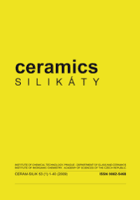
CERAMICS-SILIKATY
Pioneering Insights in Analytical Chemistry and EngineeringCERAMICS-SILIKATY is a distinguished open-access journal published by the University of Chemistry and Technology, Prague, specializing in the fields of Ceramics and Composites, Analytical Chemistry, Chemical Engineering, and Materials Chemistry. Since its inception in 1991, this journal has played a pivotal role in disseminating cutting-edge research and innovative findings in the study of ceramics, emphasizing both fundamental and applied aspects. With a commitment to accessibility since 2000, CERAMICS-SILIKATY promotes knowledge sharing among researchers, professionals, and students globally. The journal's current standing in the Q3 Quartile across several categories highlights its significant contributions and relevance in the academic community. As a hub for interdisciplinary research, the journal invites submissions that advanced our understanding of ceramic materials and their applications, positioning itself as an essential resource for those engaged in the forefront of materials science.
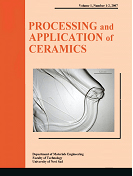
Processing and Application of Ceramics
Unlocking the Potential of Ceramic MaterialsProcessing and Application of Ceramics is a prominent open-access journal dedicated to the advancement of knowledge in the field of ceramics and composites. Published by the University of Novi Sad, Faculty of Technology in Serbia, this journal has been fostering research and innovation since its inception in 2007. With its ISSN 1820-6131 and E-ISSN 2406-1034, this journal is indexed in Scopus, where it holds a ranking of #82 out of 127 in the Materials Science category, placing it in the 35th percentile and within the Q3 quartile as of 2023. Spanning a convergence period from 2014 to 2024, the journal serves as a vital platform for researchers, professionals, and students alike, eager to explore the latest developments in ceramic materials, their processing techniques, and practical applications. The journal's commitment to accessibility and quality makes it an essential resource for those aiming to stay at the forefront of ceramics research.
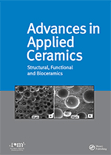
Advances in Applied Ceramics
Unlocking the Potential of Ceramics in Modern ApplicationsAdvances in Applied Ceramics is a prestigious journal published by SAGE Publications Inc, specializing in the dynamic fields of ceramics and composites, as well as industrial and manufacturing engineering. Established in 2004 and currently holding a notable Q3 ranking in Ceramics and Composites and a Q2 ranking in Industrial and Manufacturing Engineering, this journal is dedicated to disseminating innovative research and practical applications that advance the understanding and functionality of ceramics within various industries. With an impressive impact factor reflecting its academic influence, Advances in Applied Ceramics serves as a vital resource for researchers, professionals, and students alike, offering insights into cutting-edge developments. Accessible through extensive open access options, the journal ensures the broad dissemination of knowledge, fostering collaboration and engagement in the rapidly evolving realm of material sciences. Set in the heart of the United Kingdom, its contributions are recognized globally, placing it at the forefront of academic discourse in its field.

Journal of Ceramic Science and Technology
Connecting Theory with Practice in CeramicsJournal of Ceramic Science and Technology, published by GOLLER VERLAG GMBH in Germany, serves as a vital platform for advancements in the field of ceramics and composites. Since its inception in 2010, the journal has contributed significantly to the scholarly literature, encompassing a wide range of topics including the development of new ceramic materials, nanocomposites, and their various applications in industries such as electronics, energy, and medicine. Although currently categorized in the Q4 quartile of ceramics and composites and ranked within the lower percentile in Scopus, the journal strives to bridge the gap between fundamental research and practical implementation, fostering innovative solutions to contemporary materials challenges. With an open-access format, it ensures that valuable findings are disseminated widely, promoting collaboration and knowledge sharing among researchers, professionals, and students in the field. As it converges towards 2024, the Journal of Ceramic Science and Technology remains committed to enhancing the understanding and utilization of ceramic materials, making it an indispensable resource for those dedicated to advancing this dynamic area of study.
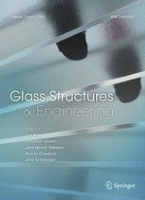
Glass Structures & Engineering
Elevating Architectural Standards with Glass Insights.Glass Structures & Engineering, published by SPRINGER INT PUBL AG, stands as a significant platform in the field of architectural and structural engineering, with a strong focus on advancements and innovative applications of glass in construction. With its ISSN 2363-5142 and E-ISSN 2363-5150, this prestigious journal holds a commendable position, evidenced by its Q1 classification in Architecture and Q2 ranking in both Building and Construction and Civil and Structural Engineering as of 2023. Since its inception in 2016, Glass Structures & Engineering has aimed to disseminate cutting-edge research findings, theoretical approaches, and case studies that explore the multifaceted uses of glass in modern infrastructure. Researchers, professionals, and students alike will find this journal an invaluable resource for the latest trends and methodologies in the evolving landscape of architectural design and structural integrity. Although it does not offer Open Access options, the journal remains an indispensable source for quality scholarly content in Switzerland and beyond.
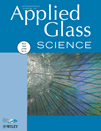
International Journal of Applied Glass Science
Pioneering Research in Glass Science and ApplicationsThe International Journal of Applied Glass Science, published by Wiley Periodicals, Inc, is a leading scholarly journal in the field of materials science, particularly focusing on the applications and innovations in glass science. Since its inception in 2010, the journal has served as a vital platform for disseminating high-quality research and advancing knowledge within the community, maintaining a respectable Q2 ranking in the Materials Science (Miscellaneous) category as of 2023. With an ISSN of 2041-1286 and E-ISSN of 2041-1294, it continues to attract a diverse array of manuscripts that explore fundamental and applied aspects of glass technology and its countless applications. Scholars and professionals benefit from the journal’s commitment to transparency and accessibility, even in the absence of an open access model, thereby reinforcing its relevance in an evolving academic landscape. The journal is positioned to be an influential resource for researchers, professionals, and students keen to stay at the forefront of glass science developments.